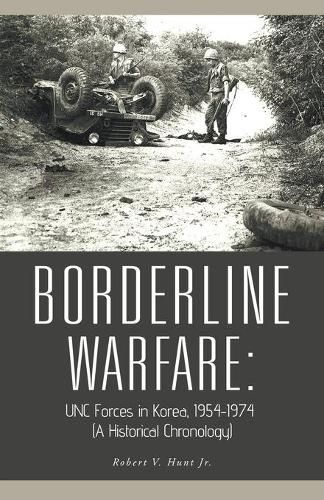Readings Newsletter
Become a Readings Member to make your shopping experience even easier.
Sign in or sign up for free!
You’re not far away from qualifying for FREE standard shipping within Australia
You’ve qualified for FREE standard shipping within Australia
The cart is loading…






This title is printed to order. This book may have been self-published. If so, we cannot guarantee the quality of the content. In the main most books will have gone through the editing process however some may not. We therefore suggest that you be aware of this before ordering this book. If in doubt check either the author or publisher’s details as we are unable to accept any returns unless they are faulty. Please contact us if you have any questions.
BORDERLINE WARFARE: United Nations Command Forces in Korea, 1954-1974 (A Historical Chronology) South Korean President Park Chung Hee, following an attempt to assassinate him in 1968, and before a similar attempt in 1970, described the North Korean Communists as the most vicious and warlike of all Communists in the world. North Korea, under the leadership of Kim Il Sung, brazenly dared the United States and South Korea to respond to the numerous provocations it inflicted on the latter. The infiltration of 31 commandos into South Korea on 21 January 1968, with the intent of murdering the South Korean president, was followed by the seizure of the USS Pueblo on 23 January 1968, off the coast of Wonsan, North Korea. Both attacks were overt attempts to create the conditions for a renewal of full-scale war on the Korean peninsula. The ever-hostile North Koreans then deliberately shot down a U.S. Navy EC-121 intelligence-gathering aircraft in April 1969, again daring the United States to respond with military force. These major actions were set against the backdrop of North Korean infiltration into South Korea with the objective of creating a Viet-Cong-like insurgency as an alternative means of toppling the South Korean government and driving out the U.S. imperialist aggressor army. From a historical perspective, only the forbearance of the U.S. and South Korean military forces prevented the escalation of hostilities that could have led to World War III.
$9.00 standard shipping within Australia
FREE standard shipping within Australia for orders over $100.00
Express & International shipping calculated at checkout
This title is printed to order. This book may have been self-published. If so, we cannot guarantee the quality of the content. In the main most books will have gone through the editing process however some may not. We therefore suggest that you be aware of this before ordering this book. If in doubt check either the author or publisher’s details as we are unable to accept any returns unless they are faulty. Please contact us if you have any questions.
BORDERLINE WARFARE: United Nations Command Forces in Korea, 1954-1974 (A Historical Chronology) South Korean President Park Chung Hee, following an attempt to assassinate him in 1968, and before a similar attempt in 1970, described the North Korean Communists as the most vicious and warlike of all Communists in the world. North Korea, under the leadership of Kim Il Sung, brazenly dared the United States and South Korea to respond to the numerous provocations it inflicted on the latter. The infiltration of 31 commandos into South Korea on 21 January 1968, with the intent of murdering the South Korean president, was followed by the seizure of the USS Pueblo on 23 January 1968, off the coast of Wonsan, North Korea. Both attacks were overt attempts to create the conditions for a renewal of full-scale war on the Korean peninsula. The ever-hostile North Koreans then deliberately shot down a U.S. Navy EC-121 intelligence-gathering aircraft in April 1969, again daring the United States to respond with military force. These major actions were set against the backdrop of North Korean infiltration into South Korea with the objective of creating a Viet-Cong-like insurgency as an alternative means of toppling the South Korean government and driving out the U.S. imperialist aggressor army. From a historical perspective, only the forbearance of the U.S. and South Korean military forces prevented the escalation of hostilities that could have led to World War III.